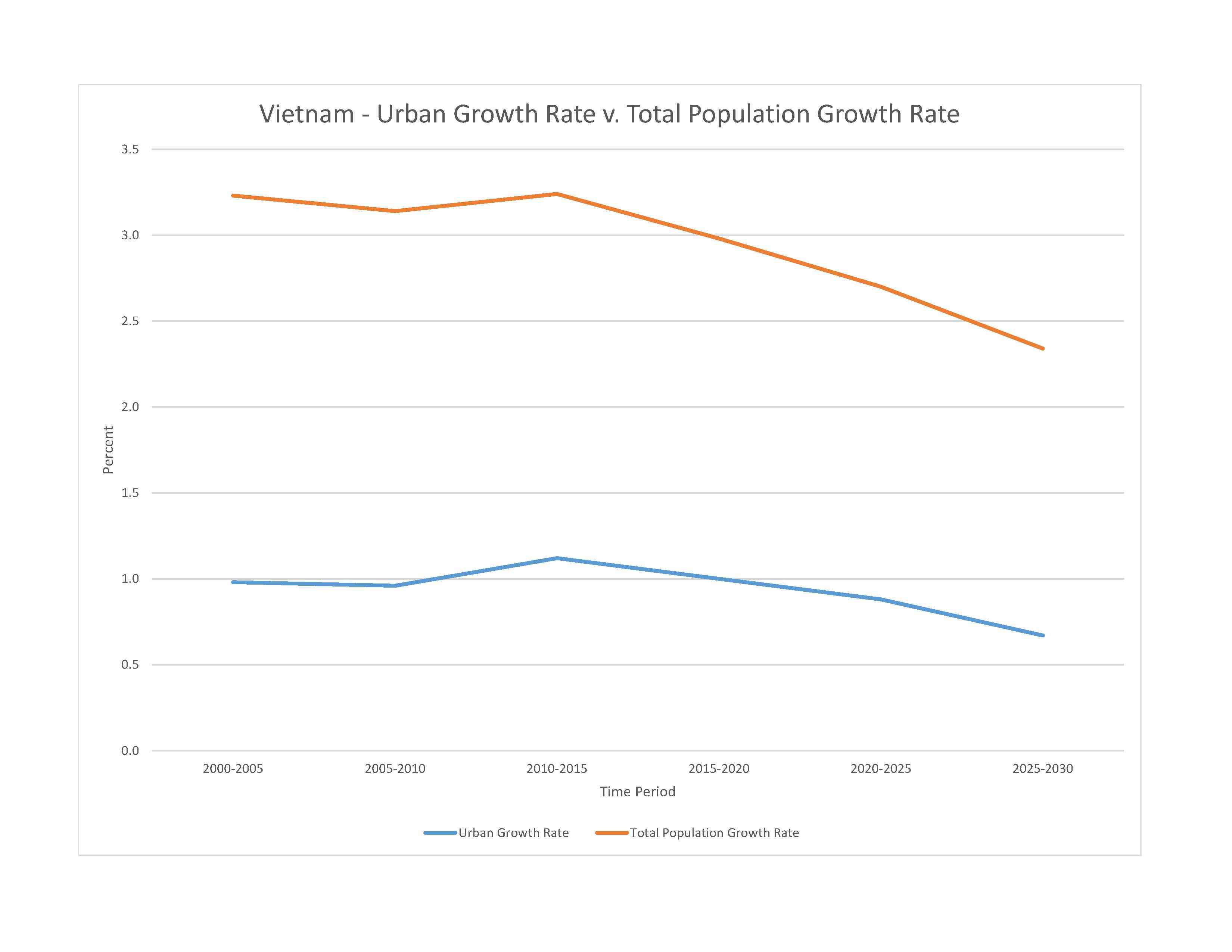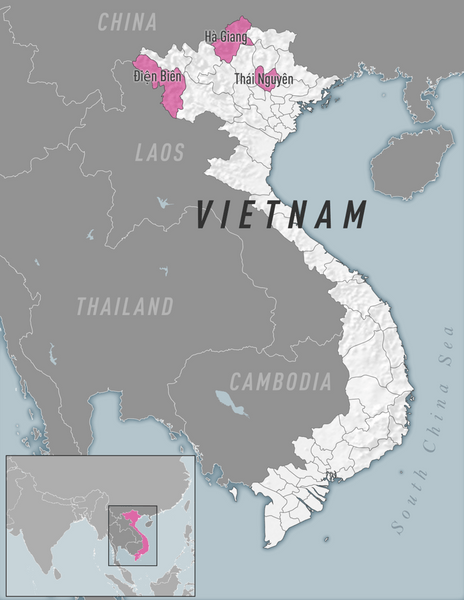
104,799,174 (2023 est.)
noun: Vietnamese (singular and plural)
adjective: Vietnamese
Kinh (Viet) 85.3%, Tay 1.9%, Thai 1.9%, Muong 1.5%, Khmer 1.4%, Mong 1.4%, Nung 1.1%, other 5.5% (2019 est.)
note: 54 ethnic groups are recognized by the Vietnamese Government
Vietnamese (official), English (increasingly favored as a second language), some French, Chinese, and Khmer, mountain area languages (Mon-Khmer and Malayo-Polynesian)
major-language sample(s):
Dữ kiện thế giới, là nguồn thông tin cơ bản không thể thiếu. (Vietnamese)
The World Factbook, the indispensable source for basic information.
Vietnamese audio sample:
Catholic 6.1%, Buddhist 5.8%, Protestant 1%, other 0.8%, none 86.3% (2019 est.)
note: most Vietnamese are culturally Buddhist
When Vietnam was reunified in 1975, the country had a youthful age structure and a high fertility rate. The population growth rate slowed dramatically during the next 25 years, as fertility declined and infant mortality and life expectancy improved. The country’s adoption of a one-or-two-child policy in 1988 led to increased rates of contraception and abortion. The total fertility rate dropped rapidly from nearly 5 in 1979 to 2.1 or replacement level in 1990, and at 1.8 is below replacement level today. Fertility is higher in the more rural central highlands and northern uplands, which are inhabited primarily by poorer ethnic minorities, and is lower among the majority Kinh, ethnic Chinese, and a few other ethnic groups, particularly in urban centers. With more than two-thirds of the population of working age (15-64), Vietnam has the potential to reap a demographic dividend for approximately three decades (between 2010 and 2040). However, its ability to do so will depend on improving the quality of education and training for its workforce and creating jobs. The Vietnamese Government is also considering changes to the country’s population policy because if the country’s fertility rate remains below replacement level, it could lead to a worker shortage in the future.
Vietnam has experienced both internal migration and net emigration, both for humanitarian and economic reasons, for the last several decades. Internal migration – rural-rural and rural-urban, temporary and permanent – continues to be a means of coping with Vietnam’s extreme weather and flooding. Although Vietnam’s population is still mainly rural, increasing numbers of young men and women have been drawn to the country’s urban centers where they are more likely to find steady jobs and higher pay in the growing industrial and service sectors.
The aftermath of the Vietnam War in 1975 resulted in an outpouring of approximately 1.6 million Vietnamese refugees over the next two decades. Between 1975 and 1997, programs such as the Orderly Departure Program and the Comprehensive Plan of Action resettled hundreds of thousands of Vietnamese refugees abroad, including the United States (880,000), China (260,000, mainly ethnic Chinese Hoa), Canada (160,000), Australia (155,000), and European countries (150,000).
In the 1980s, some Vietnamese students and workers began to migrate to allied communist countries, including the Soviet Union, Czechoslovakia, Bulgaria, and East Germany. The vast majority returned home following the fall of communism in Eastern Europe in the early 1990s. Since that time, Vietnamese labor migrants instead started to pursue opportunities in Asia and the Middle East. They often perform low-skilled jobs under harsh conditions for low pay and are vulnerable to forced labor, including debt bondage to the private brokers who arrange the work contracts. Despite Vietnam’s current labor surplus, the country has in recent years attracted some foreign workers, mainly from China and other Asian countries.
0-14 years: 23.44% (male 12,975,791/female 11,593,157)
15-64 years: 68.69% (male 36,280,449/female 35,705,586)
65 years and over: 7.87% (2023 est.) (male 3,346,804/female 4,897,387)
total dependency ratio: 45.6
youth dependency ratio: 32.8
elderly dependency ratio: 12.7
potential support ratio: 7.8 (2021 est.)
total: 32.7 years (2023 est.)
male: 31.6 years
female: 33.8 years
0.93% (2023 est.)
15.3 births/1,000 population (2023 est.)
5.8 deaths/1,000 population (2023 est.)
-0.2 migrant(s)/1,000 population (2023 est.)
though it has one of the highest population densities in the world, the population is not evenly dispersed; clustering is heaviest along the South China Sea and Gulf of Tonkin, with the Mekong Delta (in the south) and the Red River Valley (in the north) having the largest concentrations of people
urban population: 39.5% of total population (2023)
rate of urbanization: 2.7% annual rate of change (2020-25 est.)

9.321 million Ho Chi Minh City, 5.253 million HANOI (capital), 1.865 million Can Tho, 1.423 million Hai Phong, 1.221 million Da Nang, 1.111 million Bien Hoa (2023)
at birth: 1.1 male(s)/female
0-14 years: 1.12 male(s)/female
15-64 years: 1.02 male(s)/female
65 years and over: 0.68 male(s)/female
total population: 1.01 male(s)/female (2023 est.)
124 deaths/100,000 live births (2020 est.)
total: 14.4 deaths/1,000 live births (2023 est.)
male: 14.8 deaths/1,000 live births
female: 14.1 deaths/1,000 live births
total population: 75.8 years (2023 est.)
male: 73.2 years
female: 78.6 years
2.04 children born/woman (2023 est.)
0.97 (2023 est.)
72.8% (2020)
improved: urban: 99.2% of population
rural: 95.5% of population
total: 96.9% of population
unimproved: urban: 0.8% of population
rural: 4.5% of population
total: 3.1% of population (2020 est.)
4.7% of GDP (2020)
0.83 physicians/1,000 population (2016)
3.2 beds/1,000 population (2013)
improved: urban: 98.7% of population
rural: 90% of population
total: 93.3% of population
unimproved: urban: 1.3% of population
rural: 10% of population
total: 6.7% of population (2020 est.)
degree of risk: very high (2023)
food or waterborne diseases: bacterial diarrhea, hepatitis A, and typhoid fever
vectorborne diseases: dengue fever, malaria, Japanese encephalitis, and sexually transmitted diseases: hepatitis B (2024)
note: On 20 September 2023, the CDC issued a travel notice for an outbreak of diphtheria in several provinces in Vietnam (see attached map); vaccination against diphtheria is essential to protect against disease; if you are traveling to an affected area, you should be up to date with your diphtheria vaccines; Diphtheria is a serious infection caused by strains of bacteria called Corynebacterium diphtheriae that make a toxin; Diphtheria bacteria spread from person to person, usually through respiratory droplets, like from coughing or sneezing
Diphtheria outbreak in Vietnam: 
2.1% (2016)
total: 3.41 liters of pure alcohol (2019 est.)
beer: 3.18 liters of pure alcohol (2019 est.)
wine: 0.02 liters of pure alcohol (2019 est.)
spirits: 0.21 liters of pure alcohol (2019 est.)
other alcohols: 0 liters of pure alcohol (2019 est.)
total: 24.8% (2020 est.)
male: 47.4% (2020 est.)
female: 2.2% (2020 est.)
11.6% (2020)
72.6% (2023 est.)
women married by age 15: 1.1%
women married by age 18: 14.6%
men married by age 18: 1.9% (2021 est.)
4.1% of GDP (2020 est.)
definition: age 15 and over can read and write
total population: 95.8%
male: 97%
female: 94.6% (2019)
NOTE: The information regarding Vietnam on this page is re-published from the 2024 World Fact Book of the United States Central Intelligence Agency and other sources. No claims are made regarding the accuracy of Vietnam 2024 information contained here. All suggestions for corrections of any errors about Vietnam 2024 should be addressed to the CIA or the source cited on each page.
This page was last modified 04 May 24, Copyright © 2024 ITA all rights reserved.